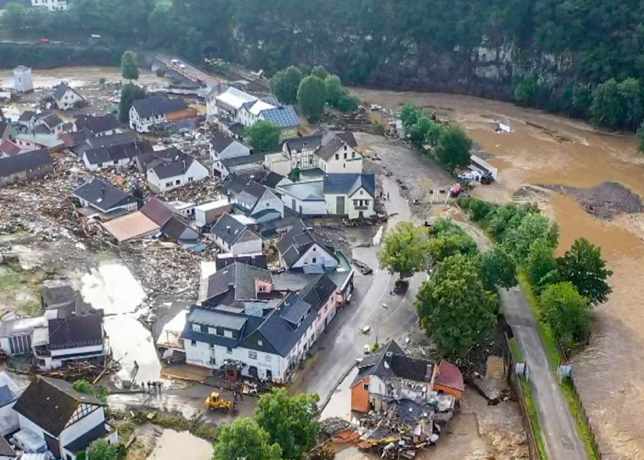Severe flooding across a number of countries in Europe looks set to become one of the most expensive flood episodes on record, with the insurance and reinsurance industry expecting billion Euro industry losses.

Flooding in Germany, photo from Christoph Reichwein – AFP
So far flooding has most severely impacted parts of Germany, Belgium, the Netherlands and also Switzerland is under threat, but with more heavy rainfall forecast for the region today and river and lake levels still rising, further damaging impacts are anticipated.
Germany has been particularly impacted, with severe property damage seen as rivers burst their banks, sadly resulting in more than 80 deaths and currently hundreds more unaccounted for.
It is the worst floods Germany has seen for decades and the torrential rainfall that caused it is being termed unprecedented by many.
Record rainfall levels drove rivers above their banks in just hours in some cases, while in other areas rivers are set to rise much further and further flooding anticipated.
The German states of Rhineland-Palatinate and North Rhine-Westphalia are the regions with the largest impacts so far, but Belgium which has reported another 11 deaths from the floods and the Netherlands have also been badly affected, with further flooding also seen in Luxembourg and Switzerland.
In Switzerland a number of lakes are close to over-topping and there is some concern for major cities there should additional rainfall prove significant.
Insurance and reinsurance broker Aon’s Impact Forecasting division has reported on the flooding event in its latest weekly catastrophe report, saying that this episode has been, “The worst regional flooding in decades resulted from record rainfall on July 13-14 that prompted the overflow of several tributaries flowing into the northern and southern branches of the Rhine River.”
As a result, Aon reports that thousands of properties have been inundated by flood water and this is likely to keep rising, with additional rivers set to burst their banks across the region and more torrential rains expected.
Additionally, there has been more severe convective storm weather across a wider swathe of Europe associated with the same systems that brought this extreme rainfall, so there will be damages across parts of France, Italy, Poland, Hungary, Slovakia and the Czech Republic to add to the main countries impacted.
Aon is expecting billion Euro plus costs from this flood event, although from the scale of the damage reported so far it does look like this ongoing flood event could end up with an economic and industry loss significantly higher.
We understand some major European re/insurers are bracing themselves for one of the most costly flooding events on-record.
As a reminder, this all comes on the heels of a very expensive June for European insurers, when Aon reported insurance and reinsurance market losses from severe storms and flooding could reach above US $4.5 billion.
The German insurers’ association, the GDV, had said that storms, floods, heavy rain and hail experienced in Germany this year could make it one of the most damaging since 2013. 2013 saw between EUR 8bn and 9bn of losses.
The GDV reported that June’s severe weather caused an estimated insurance loss of EUR 1.7 billion (around $2 billion) in Germany.
With this flooding event ongoing it is far too early to predict industry loss levels, but it is almost certain to be in the billions of Euros once all damage is accounted for across the particularly wide area of Europe that is being impacted.
Catastrophe risk modeller RMS offered the following comment yesterday, “As of today, floods have caused devastating and deadly impacts in villages and small cities situated upon minor rivers, as evidenced by the terrible images coming from Belgium, the Netherlands, and Germany. On a more worrying note, the final financial and human impact of these floods are yet unknown as floodwaters are expected to rise further over the coming days, potentially near cities with greater populations. Forecasts call for further precipitation to fall and major rivers and lakes are already full; for instance, major lakes in Switzerland have reached or are close to the levels of the devastating 1999 and 2005 floods. In the Netherlands, forecasts expect flows on the River Meuse to exceed that of the historic floods of 1993 and 1995.
“As devastating as the effects already have been, it is important to note that in the wake of past floods, mitigation measures have been implemented across Europe and their performance will have significant influence on how much damage the current floods will cause. The flooding recorded to date would have covered a much more widespread area and caused far more damage than we’ve already seen, if it were not for these measures already in place.”
Update: The floods are thought very unlikely to have an impact on the catastrophe bond market, while insurance market losses will only be a fraction of the overall economic impact, which shows the evident flood risk protection gap and the opportunity for cat bonds to help close it, according to Plenum Investments.
 View all of our Artemis Live video interviews and subscribe to our podcast.
View all of our Artemis Live video interviews and subscribe to our podcast.
All of our Artemis Live insurance-linked securities (ILS), catastrophe bonds and reinsurance video content and video interviews can be accessed online.
Our Artemis Live podcast can be subscribed to using the typical podcast services providers, including Apple, Google, Spotify and more.






























